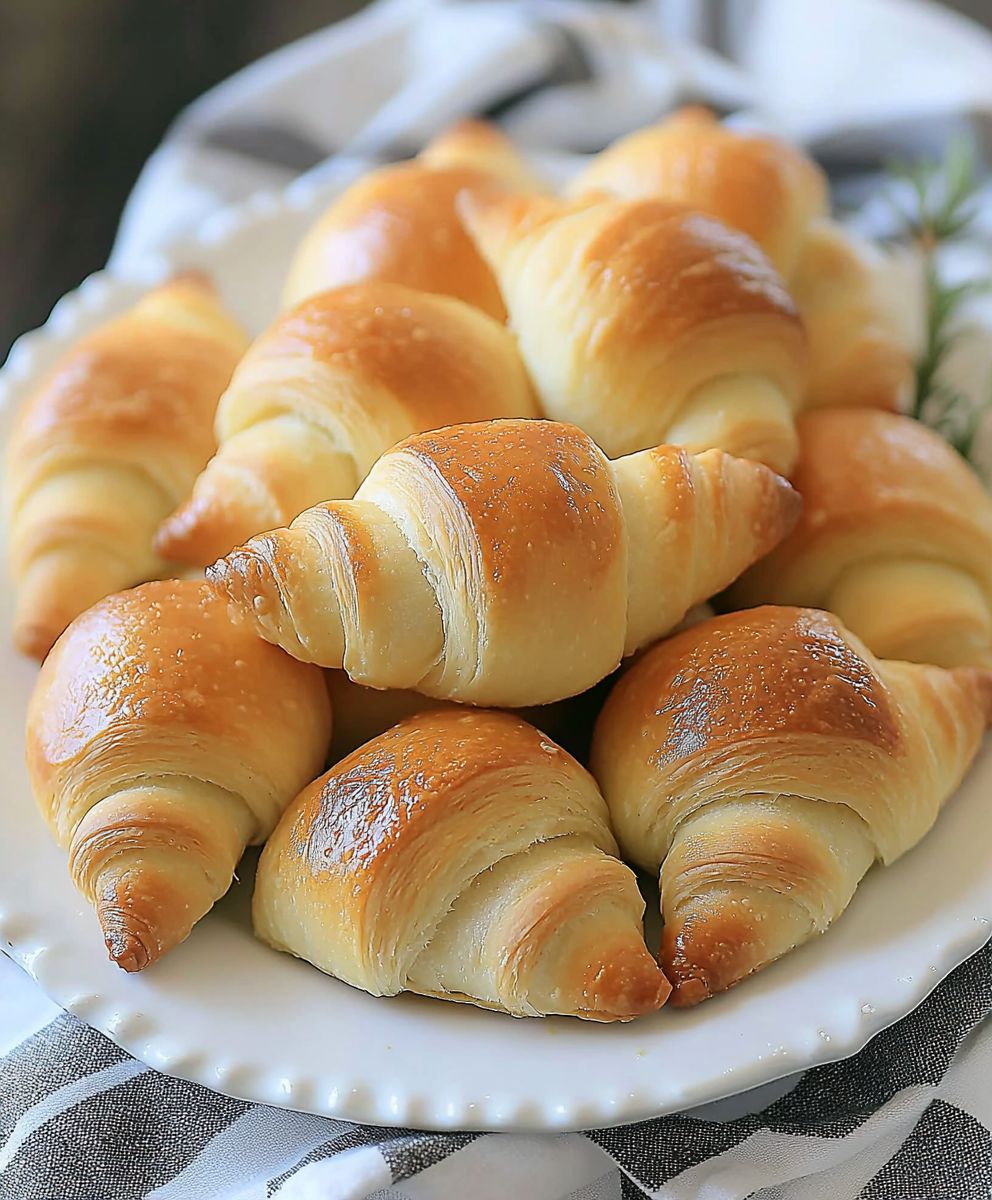Crescent rolls homemade, fresh from the oven, are a simple pleasure that elevates any meal. Imagine the aroma of warm, buttery dough filling your kitchen, a promise of the flaky, golden goodness to come. Have you ever wondered about the history of these delightful pastries? While their exact origins are debated, similar baked goods have been enjoyed for centuries, evolving into the convenient and comforting rolls we know and love today.
There’s something undeniably special about making crescent rolls homemade. Store-bought versions simply can’t compare to the taste and texture of freshly baked rolls. The layers of buttery dough create a light and airy interior, while the exterior boasts a satisfying crispness. People adore them for their versatility they’re perfect alongside a hearty soup, as a side for a holiday feast, or even as a base for mini pizzas. Plus, the process of making them, though requiring a little patience, is incredibly rewarding. So, let’s embark on this baking adventure together and create some unforgettable homemade crescent rolls!
Ingredients:
- 2 cups all-purpose flour, plus more for dusting
- 1 teaspoon salt
- 1 cup (2 sticks) cold unsalted butter, cut into 1/2-inch cubes
- 1 cup ice water
- 1 tablespoon white vinegar
- 1 large egg, beaten (for egg wash)
- Optional: Sesame seeds, poppy seeds, or everything bagel seasoning for topping
Preparing the Dough:
- Combine Dry Ingredients: In a large bowl, whisk together the flour and salt. This ensures the salt is evenly distributed throughout the dough, which is crucial for flavor and gluten development.
- Incorporate the Butter: Add the cold, cubed butter to the flour mixture. Using a pastry blender or your fingertips (work quickly to keep the butter cold!), cut the butter into the flour until the mixture resembles coarse crumbs. You should still see some pea-sized pieces of butter. These pieces are what create the flaky layers in the crescent rolls. Don’t overmix! Overmixing will result in a tough dough.
- Add the Liquid: In a separate small bowl, combine the ice water and vinegar. The vinegar helps to relax the gluten in the dough, making it more tender. Gradually add the ice water mixture to the flour and butter mixture, mixing gently with a fork until just combined. Be careful not to overmix. The dough should be shaggy and slightly sticky.
- Form the Dough: Turn the dough out onto a lightly floured surface. Gently gather it into a rough ball. Don’t knead it! Kneading will develop the gluten too much and result in tough crescent rolls.
- First Fold and Chill: Gently pat the dough into a rectangle about 1 inch thick. Fold the dough into thirds, like a letter. This is called a “book fold.” Wrap the dough tightly in plastic wrap and refrigerate for at least 30 minutes, or up to 2 hours. This chilling period allows the gluten to relax and the butter to firm up, which is essential for creating flaky layers.
- Second Fold and Chill: After the first chilling period, remove the dough from the refrigerator and place it on a lightly floured surface. Repeat the folding process: gently pat the dough into a rectangle about 1 inch thick, fold it into thirds, wrap it tightly in plastic wrap, and refrigerate for another 30 minutes to 2 hours.
- Third Fold and Chill: Repeat the folding and chilling process one more time. This third fold is crucial for creating those beautiful, distinct layers in your crescent rolls. After the final chilling period, the dough is ready to be rolled out and shaped.
Shaping the Crescent Rolls:
- Prepare Your Workspace: Lightly flour a large, clean work surface. This will prevent the dough from sticking as you roll it out.
- Roll Out the Dough: Remove the dough from the refrigerator and unwrap it. Place it on the floured surface and roll it out into a large circle, about 1/8 inch thick. The thinner you roll the dough, the flakier your crescent rolls will be.
- Cut into Triangles: Using a pizza cutter or a sharp knife, cut the circle into 12-16 equal triangles. The number of triangles will determine the size of your crescent rolls. For larger rolls, cut into 12 triangles; for smaller rolls, cut into 16.
- Shape the Rolls: Starting at the wide end of each triangle, gently stretch the dough slightly and roll it up towards the point. This creates the classic crescent shape.
- Arrange on Baking Sheet: Place the shaped crescent rolls on a baking sheet lined with parchment paper. This prevents sticking and makes for easy cleanup. Leave about 2 inches of space between each roll to allow for expansion during baking.
- Proof the Rolls (Optional but Recommended): For extra fluffy crescent rolls, cover the baking sheet with a clean kitchen towel and let the rolls proof in a warm place for about 30-60 minutes, or until they have slightly puffed up. This step is optional, but it will result in a lighter and more airy texture.
Baking the Crescent Rolls:
- Preheat the Oven: Preheat your oven to 375°F (190°C). Make sure your oven is properly preheated for even baking.
- Prepare the Egg Wash: In a small bowl, whisk together the egg and a tablespoon of water to create an egg wash. This will give the crescent rolls a beautiful golden-brown color and a slightly glossy finish.
- Brush with Egg Wash: Gently brush the tops of the crescent rolls with the egg wash. Be careful not to let the egg wash drip down the sides of the rolls, as this can prevent them from rising properly.
- Add Toppings (Optional): If desired, sprinkle the tops of the crescent rolls with sesame seeds, poppy seeds, or everything bagel seasoning. This adds flavor and visual appeal.
- Bake: Bake the crescent rolls for 15-20 minutes, or until they are golden brown and cooked through. The baking time may vary depending on your oven, so keep a close eye on them.
- Cool Slightly: Remove the crescent rolls from the oven and let them cool on the baking sheet for a few minutes before transferring them to a wire rack to cool completely.
Tips for Success:
- Keep the Butter Cold: This is the most important tip for making flaky crescent rolls. Cold butter creates steam as it bakes, which separates the layers of dough.
- Don’t Overmix the Dough: Overmixing develops the gluten, resulting in tough crescent rolls. Mix the dough just until the ingredients are combined.
- Chill the Dough: Chilling the dough allows the gluten to relax and the butter to firm up, which is essential for creating flaky layers.
- Roll the Dough Thinly: The thinner you roll the dough, the flakier your crescent rolls will be.
- Proof the Rolls (Optional): Proofing the rolls before baking will result in a lighter and more airy texture.
- Use a Pizza Cutter: A pizza cutter makes it easy to cut the dough into even triangles.
- Experiment with Fillings: Get creative and add fillings to your crescent rolls, such as cheese, ham, or chocolate.
- Storage: Store leftover crescent rolls in an airtight container at room temperature for up to 2 days. You can also freeze them for longer storage. To reheat, bake in a preheated oven at 350°F (175°C) for a few minutes, or until warmed through.
Troubleshooting:
- Crescent rolls are not flaky: This is usually caused by the butter not being cold enough or the dough being overmixed. Make sure to use cold butter and mix the dough just until the ingredients are combined. Also, ensure the dough is properly chilled between folds.
- Crescent rolls are tough: This is usually caused by overmixing the dough. Mix the dough just until the ingredients are combined.
- Crescent rolls are not rising: This could be due to several factors, including using old yeast (if you added any), not proofing the rolls long enough, or the oven not being hot enough. Make sure your oven is properly preheated and that you are using fresh ingredients.
- Crescent rolls are burning: This could be due to the oven being too hot or the rolls being placed too close to the heating element. Lower the oven temperature or move the baking sheet to a lower rack.
Variations:
- Sweet Crescent Rolls: Brush the crescent rolls with melted butter and sprinkle with cinnamon sugar before baking. You can also add a sweet filling, such as Nutella or jam.
- Savory Crescent Rolls: Add savory fillings, such as cheese, ham, or spinach. You can also sprinkle the tops of the rolls with herbs, such as rosemary or thyme.
- Garlic Parmesan Crescent Rolls: Brush the crescent rolls with garlic butter and sprinkle with grated Parmesan cheese before baking.
- Everything Bagel Crescent Rolls: Brush the crescent rolls with egg wash and sprinkle with everything bagel seasoning before baking.

Conclusion:
And there you have it! I truly believe this recipe for homemade crescent rolls is a must-try, and I’m not just saying that because I wrote it. The flaky, buttery layers, the satisfyingly soft interior, and that unmistakable crescent shape it’s all just pure comfort food bliss. Forget the store-bought versions; once you taste these, you’ll never go back. They’re surprisingly easy to make, and the aroma that fills your kitchen while they’re baking is worth the effort alone.
But why exactly should you dedicate an afternoon to making these? Well, beyond the superior taste and texture, these homemade crescent rolls offer a level of satisfaction that pre-made dough simply can’t match. There’s something incredibly rewarding about creating something so delicious from scratch, knowing exactly what ingredients went into it. Plus, you can customize them to your heart’s content!
Speaking of customization, let’s talk serving suggestions and variations. These crescent rolls are fantastic on their own, warm from the oven with a pat of butter. But they’re also incredibly versatile. Imagine serving them alongside a hearty bowl of soup or stew, using them as the base for mini pizzas, or even stuffing them with ham and cheese for a quick and easy lunch.
For a sweeter treat, brush them with melted butter and sprinkle with cinnamon sugar before baking. Or, after they’ve cooled slightly, drizzle them with a simple glaze made from powdered sugar and milk. You could even add a touch of almond extract to the glaze for an extra layer of flavor.
If you’re feeling adventurous, try incorporating different herbs and spices into the dough itself. A sprinkle of dried rosemary or thyme would add a savory note, while a pinch of garlic powder would create a delicious garlic bread alternative. You could even add a bit of grated Parmesan cheese to the dough for a cheesy twist.
Another fun variation is to fill the crescent rolls before baking. Try adding a spoonful of Nutella for a chocolatey treat, or a dollop of cream cheese and a few berries for a sweet and tangy breakfast pastry. The possibilities are truly endless!
I know baking from scratch can sometimes seem intimidating, but trust me, this recipe is foolproof. Just follow the instructions carefully, and you’ll be rewarded with the most delicious, homemade crescent rolls you’ve ever tasted. Don’t be afraid to experiment with different fillings and toppings to create your own signature version.
So, what are you waiting for? Gather your ingredients, preheat your oven, and get ready to embark on a baking adventure. I’m confident that you’ll love these homemade crescent rolls as much as I do.
And now for the most important part: I want to hear about your experience! Did you try the recipe? What variations did you make? How did they turn out? Please, share your photos and stories in the comments below. I can’t wait to see what you create! Happy baking! I am sure you will enjoy these homemade crescent rolls.
Crescent Rolls Homemade: The Ultimate Guide to Baking Perfect Rolls
Flaky, homemade crescent rolls made from scratch. Perfect for breakfast, brunch, or a side dish.
Ingredients
- 2 cups all-purpose flour, plus more for dusting
- 1 teaspoon salt
- 1 cup (2 sticks) cold unsalted butter, cut into 1/2-inch cubes
- 1 cup ice water
- 1 tablespoon white vinegar
- 1 large egg, beaten (for egg wash)
- Optional: Sesame seeds, poppy seeds, or everything bagel seasoning for topping
Instructions
- In a large bowl, whisk together the flour and salt.
- Add the cold, cubed butter to the flour mixture. Using a pastry blender or your fingertips (work quickly to keep the butter cold!), cut the butter into the flour until the mixture resembles coarse crumbs. You should still see some pea-sized pieces of butter.
- In a separate small bowl, combine the ice water and vinegar. Gradually add the ice water mixture to the flour and butter mixture, mixing gently with a fork until just combined. The dough should be shaggy and slightly sticky.
- Turn the dough out onto a lightly floured surface. Gently gather it into a rough ball. Don’t knead it!
- Gently pat the dough into a rectangle about 1 inch thick. Fold the dough into thirds, like a letter. Wrap the dough tightly in plastic wrap and refrigerate for at least 30 minutes, or up to 2 hours.
- After the first chilling period, remove the dough from the refrigerator and place it on a lightly floured surface. Repeat the folding process: gently pat the dough into a rectangle about 1 inch thick, fold it into thirds, wrap it tightly in plastic wrap, and refrigerate for another 30 minutes to 2 hours.
- Repeat the folding and chilling process one more time. After the final chilling period, the dough is ready to be rolled out and shaped.
- Lightly flour a large, clean work surface.
- Remove the dough from the refrigerator and unwrap it. Place it on the floured surface and roll it out into a large circle, about 1/8 inch thick.
- Using a pizza cutter or a sharp knife, cut the circle into 12-16 equal triangles.
- Starting at the wide end of each triangle, gently stretch the dough slightly and roll it up towards the point.
- Place the shaped crescent rolls on a baking sheet lined with parchment paper. Leave about 2 inches of space between each roll to allow for expansion during baking.
- For extra fluffy crescent rolls, cover the baking sheet with a clean kitchen towel and let the rolls proof in a warm place for about 30-60 minutes, or until they have slightly puffed up.
- Preheat your oven to 375°F (190°C).
- In a small bowl, whisk together the egg and a tablespoon of water to create an egg wash.
- Gently brush the tops of the crescent rolls with the egg wash.
- If desired, sprinkle the tops of the crescent rolls with sesame seeds, poppy seeds, or everything bagel seasoning.
- Bake the crescent rolls for 15-20 minutes, or until they are golden brown and cooked through.
- Remove the crescent rolls from the oven and let them cool on the baking sheet for a few minutes before transferring them to a wire rack to cool completely.
Notes
- Keep the Butter Cold: This is the most important tip for making flaky crescent rolls.
- Don’t Overmix the Dough: Overmixing develops the gluten, resulting in tough crescent rolls.
- Chill the Dough: Chilling the dough allows the gluten to relax and the butter to firm up.
- Roll the Dough Thinly: The thinner you roll the dough, the flakier your crescent rolls will be.
- Proof the Rolls (Optional): Proofing the rolls before baking will result in a lighter and more airy texture.
- Use a Pizza Cutter: A pizza cutter makes it easy to cut the dough into even triangles.
- Experiment with Fillings: Get creative and add fillings to your crescent rolls, such as cheese, ham, or chocolate.
- Storage: Store leftover crescent rolls in an airtight container at room temperature for up to 2 days. You can also freeze them for longer storage. To reheat, bake in a preheated oven at 350°F (175°C) for a few minutes, or until warmed through.





Leave a Comment